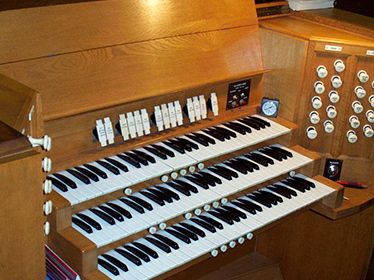Worship and Music
Services at Auburn adapt the liturgies of classical Christian worship to express the congregation’s prayers of praise, thanksgiving and confession of faith, using music drawn from earliest hymnody and anthems through to the 21st century, with the help of the choir and the historic (1889) Fincham organ. Our preachers relate biblical exposition to contemporary concerns that speak to the realities of world events in the light of the good news of Jesus the Christ.
Worship therefore becomes both a learning of new insights and a rehearsal of timeless truths on which all Christian churches depend. Auburn’s congregation is helped to understand the hope of renewal for the world as it is, so that it becomes the world as it is meant to be, through the life, death and resurrection of Christ for all people, whether within the communion of Christians or not.
Music is integral to the life of the Auburn Uniting church. We have a strong musical tradition dating back over 125 years – to the times of Wesleyans and Methodists before 1977. The directors of music and organists have continued the tradition of choosing the best of liturgical music from all denominations. The current choir sings from musical sources as diverse as the Australian Catholic Worship Book, the U.S Episcopal Church’s Psalms and Canticles for Singing, and Royal School of Church Music’s special services Veni Emmanuel in Advent and The Way of the Cross in Lent or Holy Week.
The choir and organist provide for the weekly worship services with a large variety of sung elements chosen to suit the liturgical season and the lectionary readings for the day. These include an introit, a sung psalm, occasional canticles and a weekly anthem.
The music is strongly supported and greatly valued by the Auburn congregation and visitors. Music styles range from plainsong through anthems from many centuries, traditional hymns (from Together in Song) to contemporary Australian, the Taize community, and pieces from other cultures.
Monthly communion services/celebrations of the Eucharist are sung to such settings as Geoffrey Cox’s Eucharist for Congregation and Philip Mathias’s Christ Church Mass.
Director and Organists
Ms Anne Friend is the Music Director, replacing Bruce Macrae, who retired at the end of October 2022. Margaret Pettitt is our resident organist, with Alan Chaffee playing on the first Sunday of each month. Both Margaret and Alan play classical music before and after the Sunday morning worship service.

The Organ
The historic organ was built and installed in the church for its opening in 1889 by the Melbourne firm of Fincham and Hobday. George Fincham (1828-1910) was born in London, and served his apprenticeship under Henry Bevington, some of whose organs are also in Australia. Arthur Hobday was apprenticed to, and later a partner of, “grandfather” George Fincham.
The organ originally had two manuals and 20 stops and has been enlarged three times. In 1922, additions to the organ were carried out by J W Slatterie, an apprentice to George Fincham, who had started his own organ works in Melbourne. Most recently, in 1967, the size of the organ was increased to three manuals, 38 stops and about 1700 pipes by Hill, Norman and Beard.
The organ in its present form therefore represents hundreds of years of English and Australian organ building tradition, and is a fine example of Victorian craftsmanship. It is one of the larger Fincham organs of the late 19th century still in its original location in Melbourne. The case was designed by the church’s architect, Alfred Dunn, rather than the organ builder.

